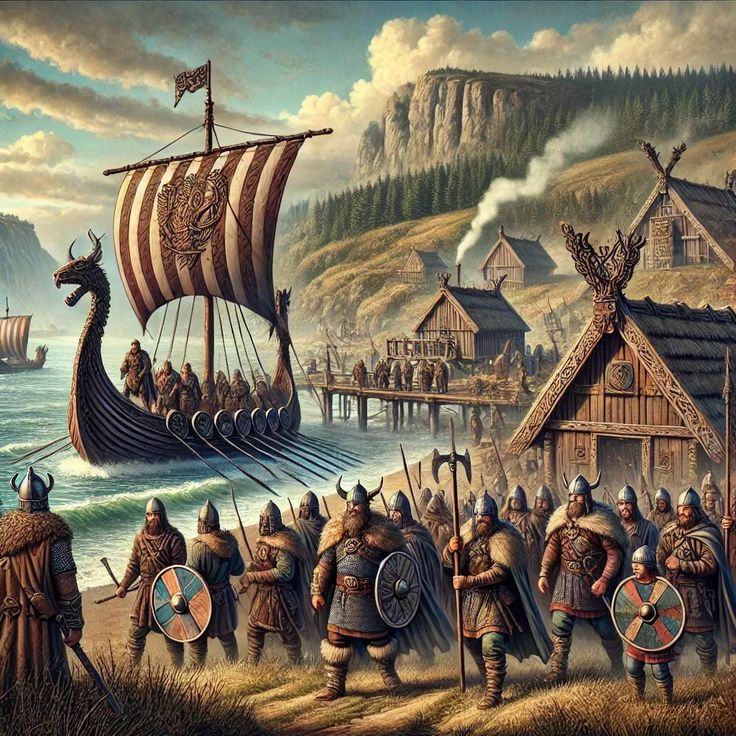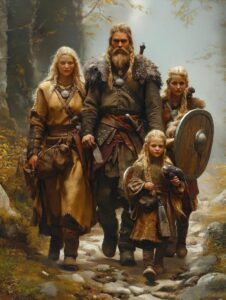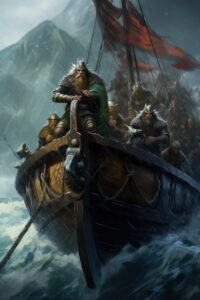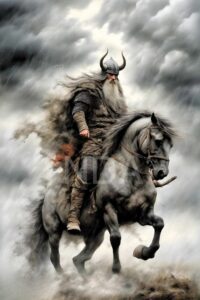
Shenali Dawson
The Vikings lived in Scandinavia over 1000 years ago. They spread terror throughout Europe from around AD 800 to 1100. Viking warriors made fierce raids on peaceful villages, they battled to win new land, they plundered treasures and snatched people to sell as slaves. Viking merchants travelled vast distances through Europe to the Middle East, selling jewelry and fine goods. Viking families set up farms in England, Ireland, Scotland and France while explorers sailed west to start new settlements in Iceland, Greenland and Russia and were the first Europeans to reach North America, around AD 1000.

There were many Viking kings with strange names and one of them were King Harald Bluetooth who left a magnificent memorial. King Harald ruled Denmark from around 935 to 985. He was one of the first Viking kings to become a Christian. He built a church at Jelling, the ancient Danish royal burial site, and had his parents’ bodies dug up and re-buried inside. He also paid for a splendid pyramid-shaped monument to be built next to the church, in memory of them. This ‘Jelling Stone’ was decorated with carvings in Viking and Christian designs. The Jelling stone has carvings of a snake and a lion-like monster, fighting together. They symbolize the forces of good and evil.
King Cnut ruled a European empire – but not the waves! King Cnut was one of the mightiest Viking kings. By 1028 he ruled England, Denmark and Norway. However, he did not want to appear too proud. So, one day, he staged a strange event on an English beach and commanded the waves to obey him! When they did not, he said, ‘This proves that I am weak. Only God can control the sea.’
Vikings sailed in dragon ships. There were different kinds of ships. Cargo ships were slow and heavy, with wide, deep hulls to carry loads. Ferry and river boats were small and sturdy, with lots of room for passengers. The most splendid ships were Drakkar (dragon ships), designed for war. They were long and speedy, with a beautifully carved stern and prow. Shallow keels helped them sail quickly onto beaches to make raids.
Sailors steered by the stars. The Vikings had no radio or satellite systems to help them navigate (steer a course) when they were out of sight of land. So, they made observations of the Sun by day and the stars by night, to work out their position. They also studied the winds, waves and ocean currents, and the movements of fish and seabirds. Shipbuilders searched for tall trees. They used oak timbers to make the keel (backbone) of each vessel. The biggest keels came from trees at least 40m high. Builders added long overlapping planks of oak, ash or birch, to make the hull. For masts, they used the trunks of very tall, very straight, trees, such as pine.

Pirates demanded gold to go away. Viking pirates such as King Svein Forkbeard of Denmark (ruled AD 985-1014) demanded money with menaces! He led Viking warships to England and promised to attack if he was not paid to sail away. Svein’s tactics worked. Each time he returned, the English handed over ‘Dane-geld’ (gold for the Danes) again and again and again! raiders carried off treasure and slaves. Viking nobles recruited gangs of warriors to go on raiding expeditions. They sailed away from Viking homelands to attack villages or defenseless monasteries. Their aim was to grab valuable treasure and healthy young men and women to sell as slaves.
Vikings valued glory more than long life. They believed that a dead warrior’s fame lived on after him and made sure that his name would never die. Myths and legends also told how warriors who died in battle would go to Valhalla, where they feasted with the gods.
Berserkers were mad for battle. Berserkers (‘bear-shirts’) were warriors who dressed in animal skins and worked themselves into a trance before battle. They charged at the enemy, howling and growling like wolves and chewing at their shields. In this state, they were wild and fearless, and dangerous to anyone who got in their way. This is where the word ‘berserk’ comes from.
Vikings honored many gods. The Aesir (sky gods) included Odin, Thor and Tyr, who were gods of war, and Loki, who was a trickster. The Vanir (gods of earth and water) included Njord (god of the sea) and Frey (the farmers’ god). He and his sister Freyja brought pleasure and fertility. Animals – and people – were killed as sacrifices. The Vikings believed that they could win favours from the gods by offering them gifts. Since life was the most valuable gift, they gave the gods living sacrifices. Vikings also cooked meals of meat – called blood-offerings – to share with the gods.
Destiny controlled the Vikings. According to legends, three sisters (Norns) decided what would happen in the world. They sat at the foot of Yggdrasil, the great tree that supported the universe, spinning ‘the thread of destiny’. They also visited each newborn baby to decide its future. Once made, this decision could not be changed.
Vikings honored heroes who died in battle. They told stories, called ‘sagas’, about their adventures so that their name and fame never died. These stories were passed on by word of mouth for many years. After the end of the Viking Age, they were written down.
Skalds sang songs and told saga stories. Viking kings and lords employed their own personal poets, called skalds. A skald’s job was to sing songs and recite poems praising his employer, and to entertain guests at feasts. Most skalds played music on harps or lures to accompany their poems and songs. Viking legends told how the world would come to an end at the battle of Ragnarok. They also promised that a new world would be born from the ruins of the old.
The Vikings believed in spirits and monsters. They were unseen powers who lived in the natural world. Some, such as elves, were kind and helpful. They sent good harvests and beautiful children. Others, such as giants who ate humans, were wicked or cruel. Vikings often imagined monsters as looking like huge, fierce animals. They carved these monster heads on ships and stones to scare evil spirits away.
Lucky charms protected warriors and farmers. They wore amulets shaped like the god Thor’s magic hammer as pendants around their necks. Warriors believed that these little hammers would give them extra strength in battle. Farmers hoped they would bring fertility to their fields and animals.

Kings defeated Viking power. For centuries, kings in England, Scotland and Ireland failed to drive the Vikings away. But after AD 1000, they began to succeed. Brian Boru, high king of Ireland, defeated the Vikings in 1014, and Viking rule ended in England in 1042. Kings of Norway, descended from Vikings, ruled parts of Scotland until 1266 and Orkney and Shetland until 1469.
Christianity destroyed faith in Viking gods. The Vikings believed their gods would punish them if they did not worship them, and would kill Christian missionaries. But the missionaries survived. So did Vikings who became Christians. This made other Vikings wonder if their gods had any powers, at all.
Vikings set up new kingdoms outside Viking lands. In places far away from the Viking homelands, such as Novgorod in Russia, or Normandy, in northern France, Viking warlords set up kingdoms that developed independently. Over the years, they lost touch with their Viking origins, and created new customs, laws and lifestyles of their own.
Viking settlers abandoned America. Soon after AD 1000, Thorfinn Karlsefni, a Viking merchant from Iceland, led over 100 Viking men and women to settle at Vinland – the site in North America where Leif Eriksson landed. They stayed there for two years, but left because the Native North Americans attacked them and drove them away.